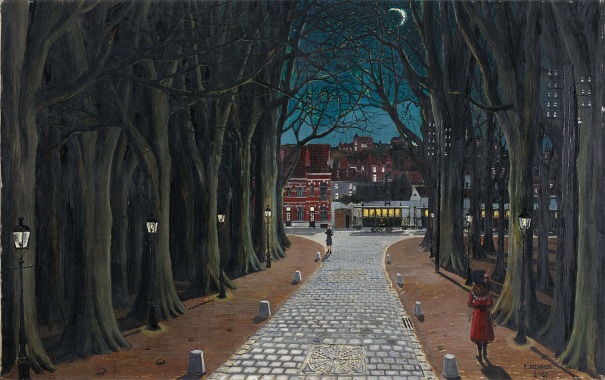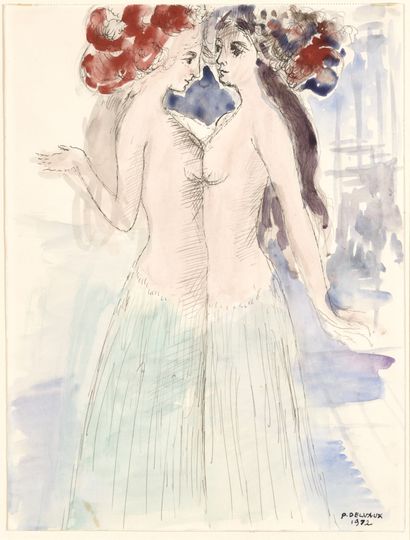Size73 x 92,7 cm MaterialOil on canvas OriginBelgium Wanze 1897 - Veurne 1994 Combat de squelettes - 1934 Signed and dated P. Delvaux 7-34 Certificate by the Paul Delvaux Fondation, St Idesbald, 25 September 2017-12-09 Provenance: Gift from the artist to the first owner in 1934 By descent to the current owner Exhibited: Salon quatriennal Antwerp, 1934 Texte en français à la suite - Nederlands tekst aan het einde Combat de Squelettes A newly discovered and historical painting by Paul Delvaux July 1934 Discovering an unknown work by a well-known artist such as Paul Delvaux is always an experience for an art lover. The unravelling of the story behind a painting enables us to penetrate its relationship to the wider oeuvre and allows us to give it a place within the artist’s production. The oil painting Skeletons Fighting is inscribed July 1934. Such precise dating allows us to situate the work in time and compare it to a drawing made one month earlier, in June of the same year (picture n° 3). While the subjects of both works are similar, the titles differ: the painting refers to Fighting, whereas the drawing is called Duelling Skeletons. The latter work is executed in India ink, wash and watercolour on paper and was made by Paul Delvaux in Spy, a village in the region of Namur where his cousin Walter Delvaux was then living. Nine years younger than Paul, Walter had been fascinated by the art of his older cousin since childhood. The artist was touched by this genuine interest in his work, especially since he received little support from his family at the beginning of his career. A friendship developed between the two cousins that lasted until old age. In the early 1930s, Paul regularly visited Walter, who had trained as a doctor. The following anecdote has been passed down orally: invited to dinner by one of Walter’s friends, Paul Delvaux - who often had his head in the clouds - broke three crystal glasses. Confused and shy, he made amends by offering the aforementioned painting to the family. The owner preserved it carefully and passed it down to the next generation. Always kept in good lighting conditions and hardly manipulated, the canvas retains all its original freshness, which is rare. This canvas occupies an important place in Delvaux’s oeuvre. It is the first known and inventoried painting in which the artist brings skeletons to life. Skeletons are an important element in Delvaux’s world. At the age of seven, Delvaux saw a skeleton in the biology classroom through which he had to walk in order to attend piano lessons, and was profoundly impressed. Later, his anatomy lessons at the Museum of Natural Sciences in Brussels reawakened his interest in the subject. Delvaux studied the structure of the human body and familiarised himself with the anatomy of the skeleton. He first introduced the skeleton as a bystander in paintings with multiple figures, as evidenced by the two versions of Sleeping Venus (1932), the second of which is lost. Several drawings from 1934, and Fighting in particular, bear witness to a new approach: the skeleton now becomes a fully- edged, living figure. The fact that this painting exclusively depicts skeletons makes it particularly original. We see two opposing figures - one of whom brandishes his sword in readiness to strike a fatal blow to his adversary, whose weapon hangs by his side. The setting is a sombre, shadowy space that is practically empty, so that all the attention is focused on the essence. By stripping man of his flesh, Delvaux reduces him to his universal essence and reminds us of the familiar adage ‘we are all equal in the face of death.’ All physical or social distinctions disappear, as evidenced by the red mantle hanging from a peg that is reduced to a remnant. Its presence seems to have been dictated by purely functional considerations. Camille Brasseur Texte en Français Combat de Squelettes de Paul Delvaux juillet 1934 Une oeuvre inédite et historique de Paul Delvaux Juillet 1934
Size73 x 92,7 cm MaterialOil on canvas OriginBelgium Wanze 1897 - Veurne 1994 Combat de squelettes - 1934 Signed and dated P. Delvaux 7-34 Certificate by the Paul Delvaux Fondation, St Idesbald, 25 September 2017-12-09 Provenance: Gift from the artist to the first owner in 1934 By descent to the current owner Exhibited: Salon quatriennal Antwerp, 1934 Texte en français à la suite - Nederlands tekst aan het einde Combat de Squelettes A newly discovered and historical painting by Paul Delvaux July 1934 Discovering an unknown work by a well-known artist such as Paul Delvaux is always an experience for an art lover. The unravelling of the story behind a painting enables us to penetrate its relationship to the wider oeuvre and allows us to give it a place within the artist’s production. The oil painting Skeletons Fighting is inscribed July 1934. Such precise dating allows us to situate the work in time and compare it to a drawing made one month earlier, in June of the same year (picture n° 3). While the subjects of both works are similar, the titles differ: the painting refers to Fighting, whereas the drawing is called Duelling Skeletons. The latter work is executed in India ink, wash and watercolour on paper and was made by Paul Delvaux in Spy, a village in the region of Namur where his cousin Walter Delvaux was then living. Nine years younger than Paul, Walter had been fascinated by the art of his older cousin since childhood. The artist was touched by this genuine interest in his work, especially since he received little support from his family at the beginning of his career. A friendship developed between the two cousins that lasted until old age. In the early 1930s, Paul regularly visited Walter, who had trained as a doctor. The following anecdote has been passed down orally: invited to dinner by one of Walter’s friends, Paul Delvaux - who often had his head in the clouds - broke three crystal glasses. Confused and shy, he made amends by offering the aforementioned painting to the family. The owner preserved it carefully and passed it down to the next generation. Always kept in good lighting conditions and hardly manipulated, the canvas retains all its original freshness, which is rare. This canvas occupies an important place in Delvaux’s oeuvre. It is the first known and inventoried painting in which the artist brings skeletons to life. Skeletons are an important element in Delvaux’s world. At the age of seven, Delvaux saw a skeleton in the biology classroom through which he had to walk in order to attend piano lessons, and was profoundly impressed. Later, his anatomy lessons at the Museum of Natural Sciences in Brussels reawakened his interest in the subject. Delvaux studied the structure of the human body and familiarised himself with the anatomy of the skeleton. He first introduced the skeleton as a bystander in paintings with multiple figures, as evidenced by the two versions of Sleeping Venus (1932), the second of which is lost. Several drawings from 1934, and Fighting in particular, bear witness to a new approach: the skeleton now becomes a fully- edged, living figure. The fact that this painting exclusively depicts skeletons makes it particularly original. We see two opposing figures - one of whom brandishes his sword in readiness to strike a fatal blow to his adversary, whose weapon hangs by his side. The setting is a sombre, shadowy space that is practically empty, so that all the attention is focused on the essence. By stripping man of his flesh, Delvaux reduces him to his universal essence and reminds us of the familiar adage ‘we are all equal in the face of death.’ All physical or social distinctions disappear, as evidenced by the red mantle hanging from a peg that is reduced to a remnant. Its presence seems to have been dictated by purely functional considerations. Camille Brasseur Texte en Français Combat de Squelettes de Paul Delvaux juillet 1934 Une oeuvre inédite et historique de Paul Delvaux Juillet 1934




.jpg)


.jpg)






.jpg)
Try LotSearch and its premium features for 7 days - without any costs!
Be notified automatically about new items in upcoming auctions.
Create an alert